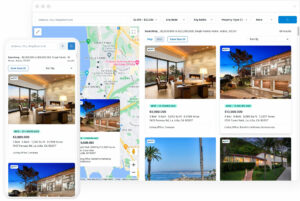On-page SEO refers to the practice of optimizing individual web pages in order to rank higher and earn more relevant traffic in search engines. This includes optimizing the content, HTML source code, and other elements of a webpage to make it more search engine friendly. On-page SEO is a crucial part of any SEO strategy, as it helps search engines understand the content and context of your website and determines how well your website will rank in search results.
One of the main goals of on-page SEO is to optimize the content of your website for both users and search engines. This means creating high-quality, relevant, and informative content that addresses the needs and interests of your target audience. It also means using the right keywords and phrases in your content, headings, and other elements of your webpage to help search engines understand the topic and context of your content.
On-page SEO is different from off-page SEO, which refers to the practice of building links from other websites to your own. While both on-page and off-page SEO are important for improving your search engine rankings, on-page SEO focuses on optimizing the content and elements of your own website, while off-page SEO focuses on building links and relationships with other websites.
In this article, we’ll go through the various aspects of on-page SEO and provide tips and best practices for optimizing your website’s content and structure for search engines. By following these guidelines, you’ll be able to improve your search engine rankings, drive more relevant traffic to your website, and increase the visibility and credibility of your business online.
Keyword Research
Keyword research is the process of identifying the words and phrases that your target audience uses when searching for information online. By understanding the keywords and phrases that people use to find products and services like yours, you can create content that is more relevant, useful, and attractive to your target audience.
There are several tools you can use to conduct keyword research, including:
- Google’s Keyword Planner: This tool is designed for advertisers, but it can also be used by SEOs to get an idea of the search volume and competition for specific keywords.
- Ahrefs: This is a paid tool that offers a range of keyword research and analysis features, including search volume data, keyword difficulty scores, and suggestions for related keywords.
- SEMrush: This is another paid tool that offers a range of keyword research and analysis features, including search volume data, keyword difficulty scores, and suggestions for related keywords.
Once you have a list of keywords and phrases that are relevant to your business and have a decent search volume, you can start incorporating them into your website’s content. Here are a few tips for using keywords effectively in your content:
- Use your target keywords in the title, headings, and subheadings of your webpage.
- Use your target keywords throughout your content, but don’t overdo it. Search engines may penalize websites that stuff their content with too many keywords.
- Use synonyms and related phrases to add variety to your content and avoid keyword stuffing.
- Use modifiers, such as “best,” “top,” or “review,” to create long-tail keywords that are more specific and attract more qualified traffic.
By conducting thorough keyword research and using your target keywords effectively in your content, you can help search engines understand the context and relevance of your website and improve your search engine rankings.
Title Tags and Meta Descriptions
Title tags and meta descriptions are HTML elements that are used to summarize the content of a webpage. They are important for on-page SEO because they help search engines understand the context and relevance of your content and can affect how your website appears in search results.
Title tags are the text that appears in the browser tab when you open a webpage and are also used as the title of your webpage in search results. Title tags should be concise and descriptive, and should include your target keywords. Here are a few tips for writing effective title tags:
- Keep your title tags under 60 characters. Any text beyond this limit may be truncated in search results.
- Use your target keywords as close to the beginning of your title tag as possible.
- Use modifiers, such as “best,” “top,” or “review,” to create long-tail keywords that are more specific and attract more qualified traffic.
Meta descriptions are brief summaries of a webpage’s content that appear under the title in search results. Meta descriptions should be compelling and informative and should include your target keywords. Here are a few tips for writing effective meta descriptions:
- Keep your meta descriptions under 160 characters. Any text beyond this limit may be truncated in search results.
- Use your target keywords in your meta descriptions, but don’t overdo it.
- Use numbers and adjectives to make your meta descriptions more compelling.
Our top recommendation is Yoast SEO, it’s free and very easy to use.
By writing compelling and informative title tags and meta descriptions that include your target keywords, you can improve the click-through rate of your website in search results and drive more relevant traffic to your website.
Headings and Subheadings
Headings and subheadings are important for on-page SEO because they help organize the content of your webpage and make it easier for users and search engines to understand the structure and hierarchy of your content. They also provide an opportunity to include your target keywords, which can help search engines understand the context and relevance of your content.
There are several levels of headings in HTML, from H1 (the most important) to H6 (the least important). It’s generally a good idea to use only one H1 heading per webpage, which should be the title or main heading of your content. You can then use H2 and H3 headings to organize the content into sections and sub-sections. Here are a few tips for using headings and subheadings effectively:
- Use your target keywords in your headings and subheadings where appropriate.
- Keep your headings and subheadings concise and to the point.
- Use headings and subheadings to break up your content and make it easier to read and scan.
- Use headings and subheadings to convey the hierarchy and structure of your content.
By using headings and subheadings effectively, you can help search engines understand the structure and relevance of your content and improve the user experience of your website.
Content Optimization
Content optimization refers to the practice of creating high-quality, relevant, and informative content that addresses the needs and interests of your target audience. This includes using the right keywords and phrases to help search engines understand the context and relevance of your content, as well as using internal and external links to provide additional information and context for your users.
Here are a few tips for optimizing your website’s content for search engines:
- Use your target keywords throughout your content, but don’t overdo it. Search engines may penalize websites that stuff their content with too many keywords.
- Use synonyms and related phrases to add variety to your content and avoid keyword stuffing.
- Use modifiers, such as “best,” “top,” or “review,” to create long-tail keywords that are more specific and attract more qualified traffic.
- Use internal links to other pages on your website to help users explore more content and to signal to search engines the relevance of your pages.
- Use external links to reputable sources to provide additional information to your users and to show search engines the authority of your website.
By creating high-quality, relevant, and informative content that is optimized for both users and search engines, you can improve your search engine rankings, drive more relevant traffic to your website, and increase the credibility and trustworthiness of your business.
Images and Videos
Images and videos can be a powerful tool for engaging your audience and enhancing the user experience of your website. However, it’s important to optimize your images and videos for search engines so that they can be easily discovered and indexed.
Here are a few tips for optimizing your images and videos for SEO:
- Use descriptive file names for your images and videos (e.g. “2-bedroom-apartment-downtown-san-diego.jpg”)
- Use alt tags to describe the content of your images to search engines and users who are unable to see the images.
- Use descriptive titles and captions for your videos to help search engines understand the content of your videos.
- Use the embed code provided by video hosting platforms (such as YouTube) to include videos on your website, rather than hosting the video files on your own server.
Images and videos optimized for SEO will make your content more discoverable, accessible, and enhance users’ experiences.
URL Structure
The structure of your website’s URLs can have a significant impact on your search engine rankings and the user experience of your website. Here are a few tips for creating SEO-friendly URLs:
- Use your target keywords in your URLs where appropriate.
- Keep your URLs short and easy to read.
- Use hyphens to separate words in your URLs.
- Avoid using special characters and unnecessary words in your URLs.
- Use consistent and logical URL structures throughout your website.
By following these guidelines, you can create URLs that are easy for both users and search engines to understand and that contribute to the overall SEO of your website.
Mobile Optimization
With more and more users accessing the internet from their phones and tablets, it’s essential to make sure your website is mobile-friendly. Mobile optimization refers to the practice of creating websites that are easy to use and navigate on mobile devices.
Here are a few tips for creating a mobile-friendly website:
- Use responsive design techniques to ensure that your website looks and works great on all devices.
- Use a mobile-responsive theme or hosted platform to create a mobile-friendly website.
- Keep your pages and images lightweight to improve the loading speed of your website on mobile devices.
- Use large and easy-to-tap buttons and links to improve the usability of your website on mobile devices.
By optimizing your website for mobile devices, you can improve the user experience of your website and attract more mobile users. This is especially important for local businesses, as many users search for local businesses on their mobile devices.
Page Speed
Page speed is an important factor in on-page SEO, as it can affect the user experience of your website and your search engine rankings. Users expect websites to load quickly and may become frustrated if a page takes too long to load. Search engines also consider page speed when determining the relevance and ranking of a webpage.
Here are a few tips for improving the speed of your website:
- Optimize your images by using appropriate image file formats and compressing large images.
- Minify your CSS and JavaScript files to reduce the size of your webpage.
- Use a content delivery network (CDN) to distribute the content of your website to servers around the world, which can improve the loading speed of your website for users in different locations.
- Enable browser caching to allow your website to load faster for repeat visitors.
Our top recommendation to make this as simple as possible is Nitropack, setup is less than 5 minutes and takes care of everything for you.
By improving the speed of your website, you can improve the user experience of your website and your search engine rankings.
On-Page SEO for Real Estate
For real estate professionals, a strong online presence is essential for reaching potential clients and showcasing properties. On-page SEO is an essential part of any real estate marketing strategy, as it helps search engines understand the content and context of your website and determines how well your website will rank in search results.
Identifying Keywords
- Use local keywords and phrases in your content. Keywords for real estate might include phrases such as “homes for sale,” “apartments for rent,” “townhomes,” and the name of specific neighborhoods or cities.
- You can use tools like Google’s Keyword Planner or Ahrefs to help identify the most relevant and popular keywords for your real estate website.
Optimizing Title Tags and Meta Descriptions
- In your title tags and meta descriptions, be sure to include your target keywords as well as your location (e.g. “Homes for Sale in San Diego, CA”).
- Use numbers and adjectives to make your titles and descriptions more compelling (e.g. “10 Luxury Homes for Sale in San Diego”).
Property Descriptions & Content
- Include detailed property descriptions that include the number of bedrooms, bathrooms, square footage, and any unique features or amenities. The more information you provide about your properties, the better search engines will be able to understand the context and relevance of your content.
- Use high-quality photos and virtual tours to showcase your properties and give users a sense of what it’s like to live there. Visual content is an important part of any real estate marketing strategy, as it allows users to get a feel for the property without having to visit in person.
Conclusion
In this article, we’ve covered the various aspects of on-page SEO and provided tips and best practices for optimizing your website’s content and structure for search engines. By following these guidelines, you can improve your search engine rankings, drive more relevant traffic to your website, and increase the visibility and credibility of your business online.
Some key takeaways from this article include:
- Conduct thorough keyword research to identify the right keywords for your website.
- Use title tags and meta descriptions to summarize the content of your webpage and include your target keywords.
- Use headings and subheadings to organize your content and include your target keywords.
- Create high-quality, relevant, and informative content that is optimized for both users and search engines.
- Optimize your images and videos for SEO by using descriptive file names and alt tags.
- Create SEO-friendly URLs that include your target keywords and are easy to read.
- Make sure your website is mobile-friendly to attract more mobile users.
- Improve the speed of your website to enhance the user experience and improve your search engine rankings.
You can begin implementing these on-page SEO techniques on your website by reviewing the content and structure of your current web pages. You can also conduct keyword research to identify new opportunities for optimization. The best way to ensure that your website remains competitive in search results is to review and update its on-page SEO on a regular basis.



